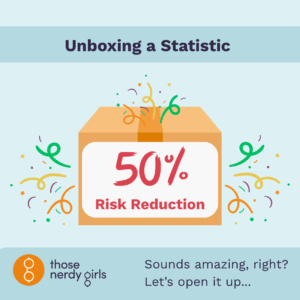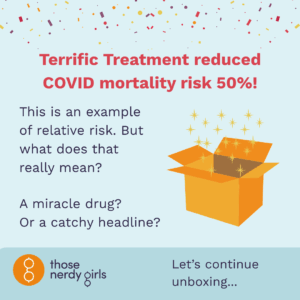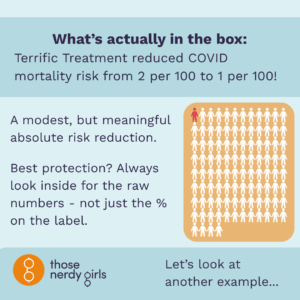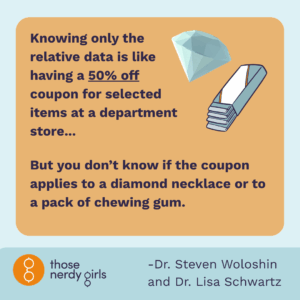This has been updated from the original post from May 26, 2020.
❓Friendly Pop Quiz!
Which of these two statements sounds more impressive?
(1) “Terrific Treatment reduced COVID mortality risk 50%!”
(2) “Terrific Treatment reduced COVID mortality risk from 2 per 100 to 1 per 100!”
The first of these two equivalent statements is, of course, the “right” answer. Which is why we scientists – in the spirit of providing full transparency – prefer to lead with the second. We also avoid reporting the 50% figure alone – and bring out the pitchforks when public officials do so! As cleverly articulated by Dr. Steven Woloshin and the late Dr. Lisa Schwartz (book reference below), “Knowing only the relative data is like having a 50% off coupon for selected items at a department store. But you don’t know if the coupon applies to a diamond necklace or to a pack of chewing gum.”
Instead, we scientists opt for statements like the following:
“2 out of 100 patients receiving standard care died, while 1 out of 100 patients receiving Terrific Treatment died, representing a 50% relative risk reduction”*
Sadly, the above statement doesn’t make for catchy headlines. Additionally, fumbling – and, to be candid, fudging – its interpretation is really easy to do. So what’s your best protection? Always seek the raw numbers provided in statement (2) – providing “absolute risk differences” in epidemiology speak – and never settle for a single metric of “relative risk reduction” such as that provided in statement (1).
And have no fear…..Your Nerdy Girls are here! We’ve got your back, and will continue separating out the hope from the hype at the information frontlines. 🫶
*Calculation: (2-1)/2 = 0.50, or 50%
📖For more great reading about absolute vs. relative risk differences, we recommend Drs. Woloshin and Schwartz’s co-authored book with Dr. Gil Welch, “Know Your Chances: Understanding Health Statistics.” Available for free from the National Library of Medicine website here.
➡️ Scroll through the slides below to “unbox the statistic,” and learn more about absolute vs relative risk.





Link to Original Facebook Post


